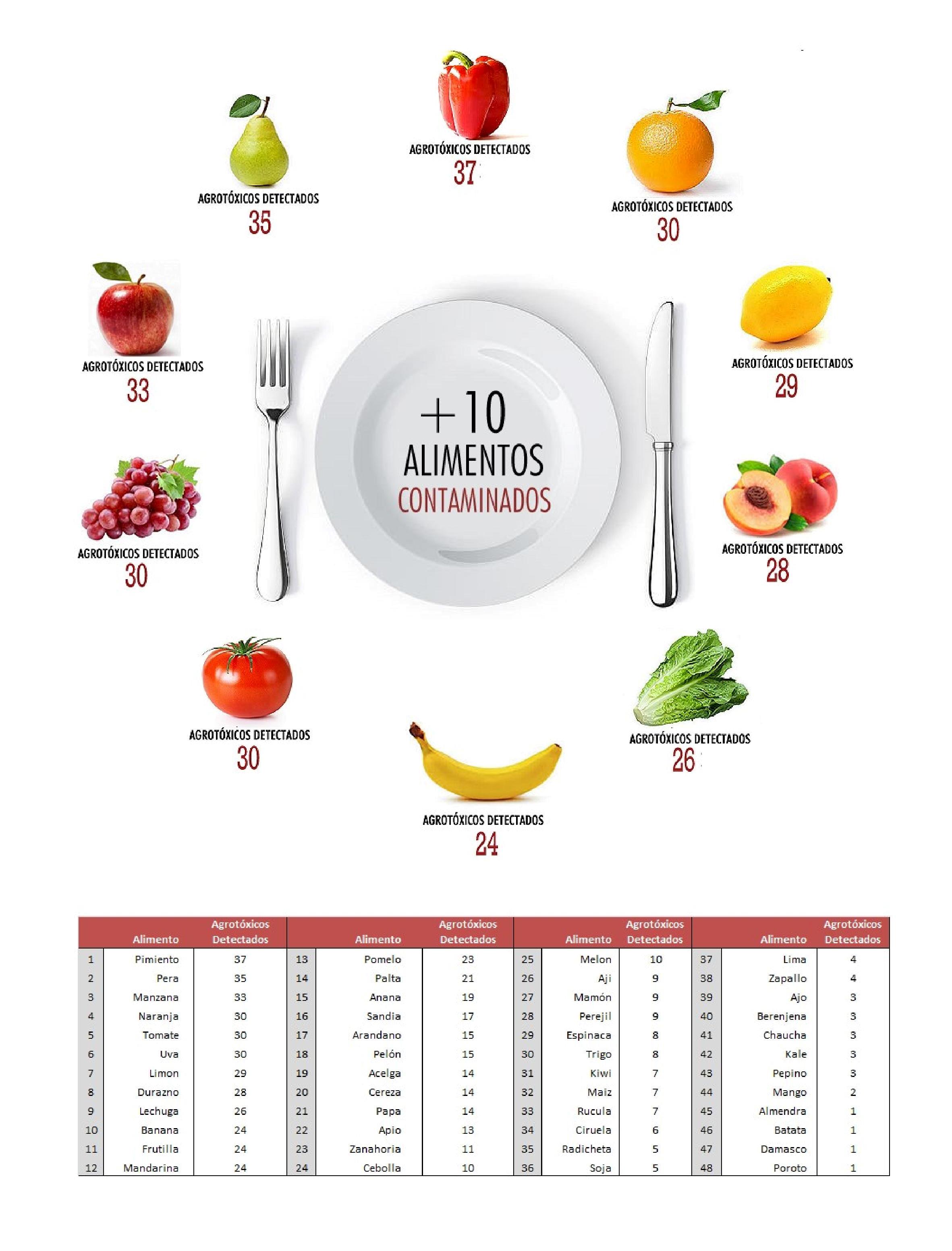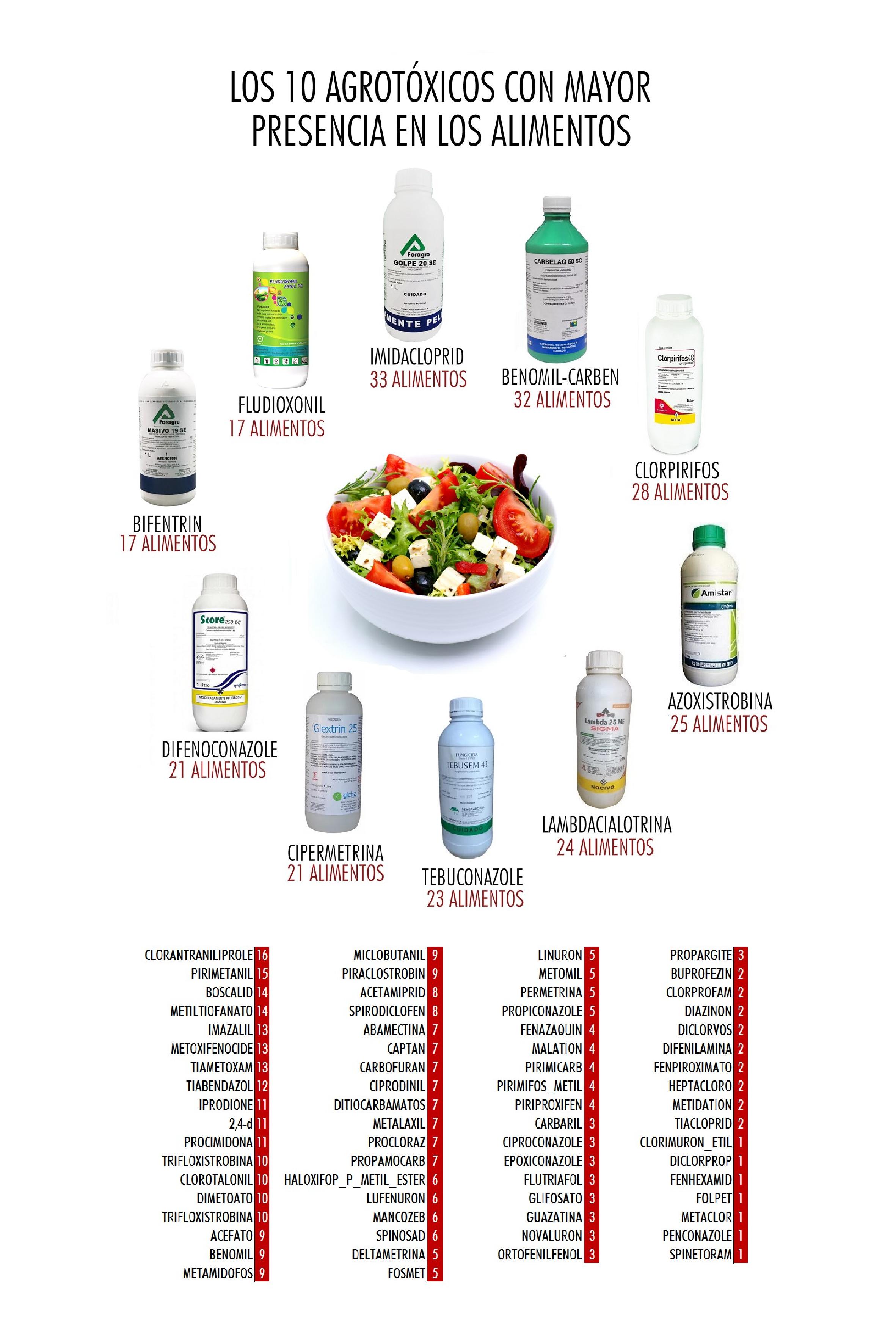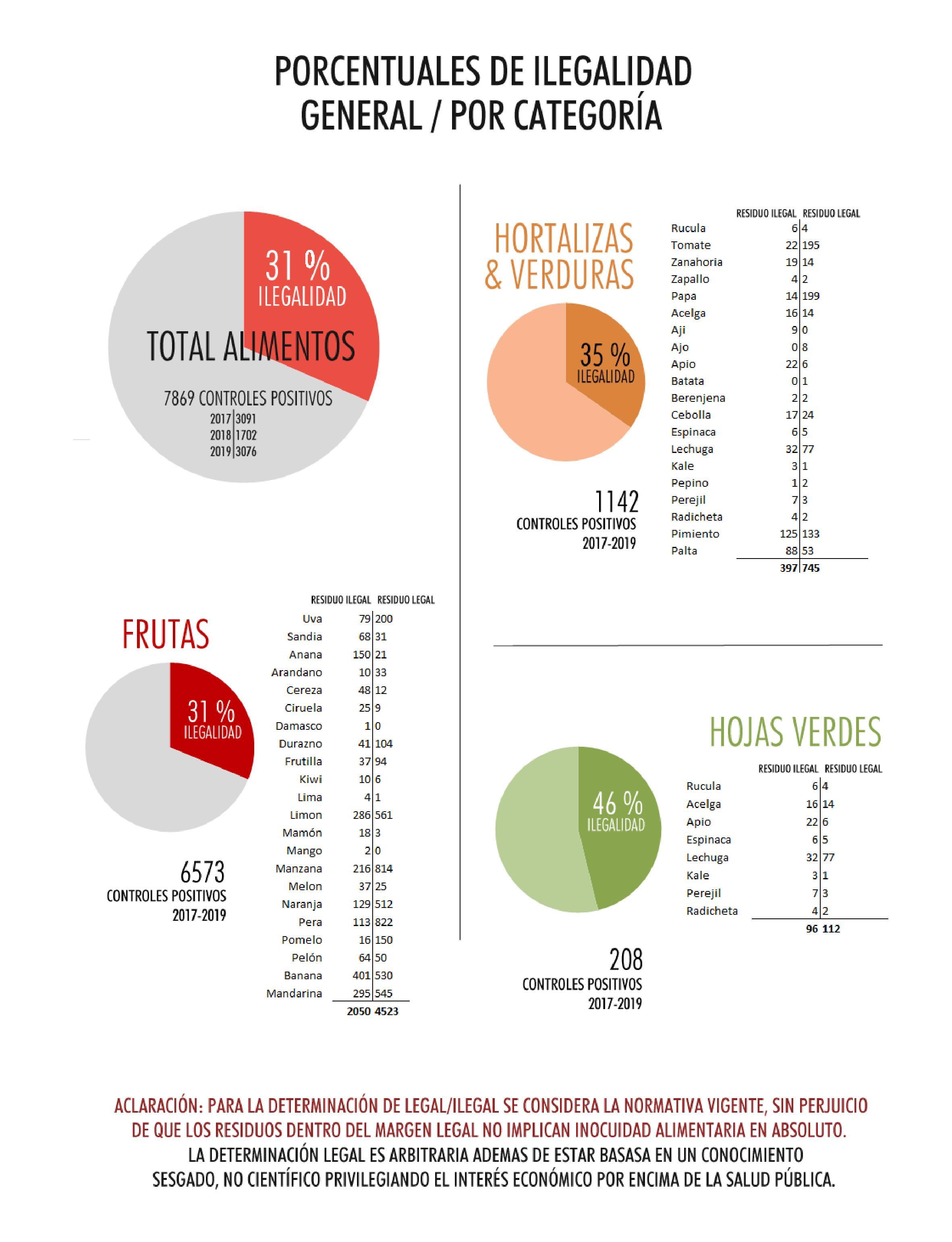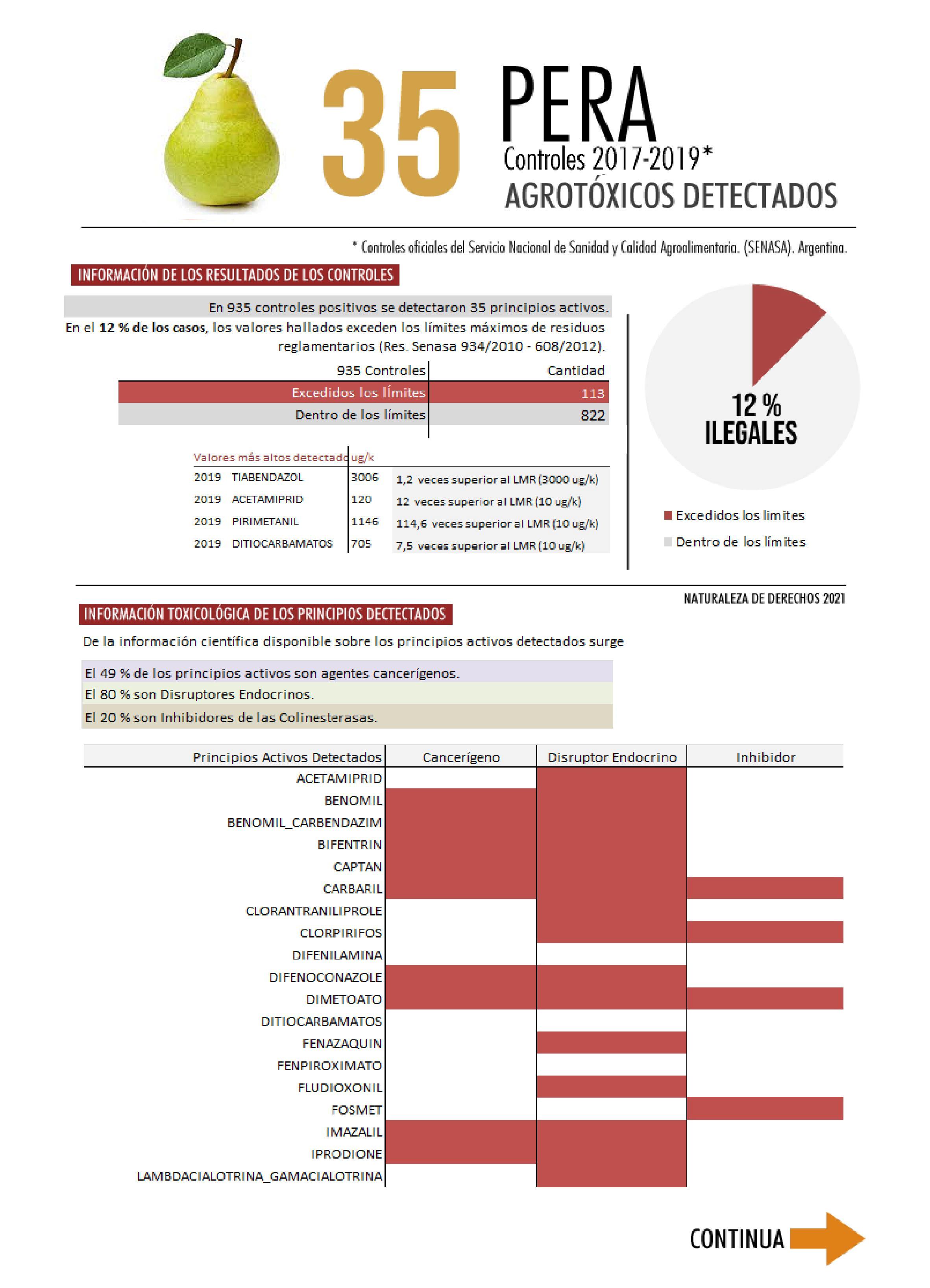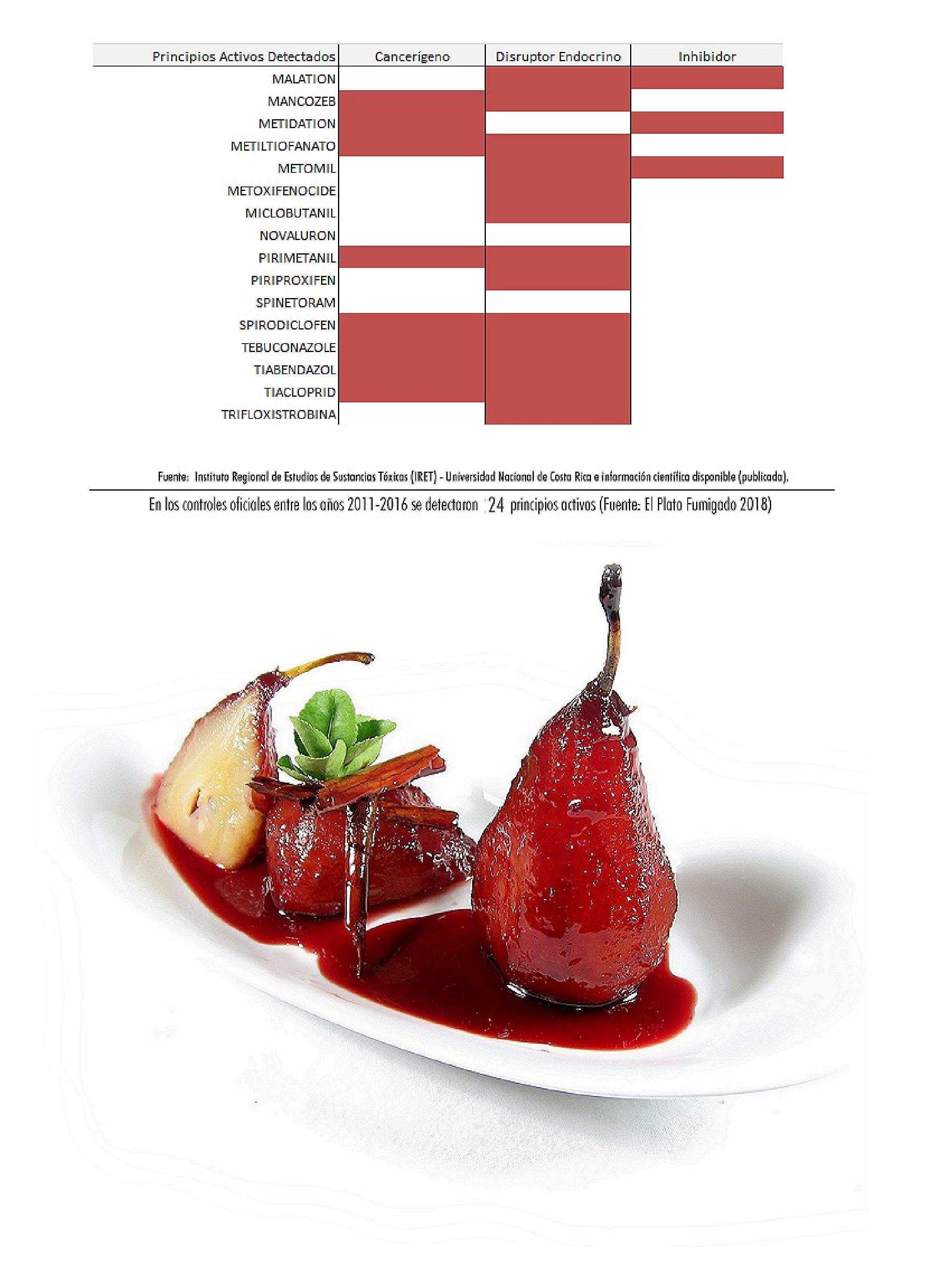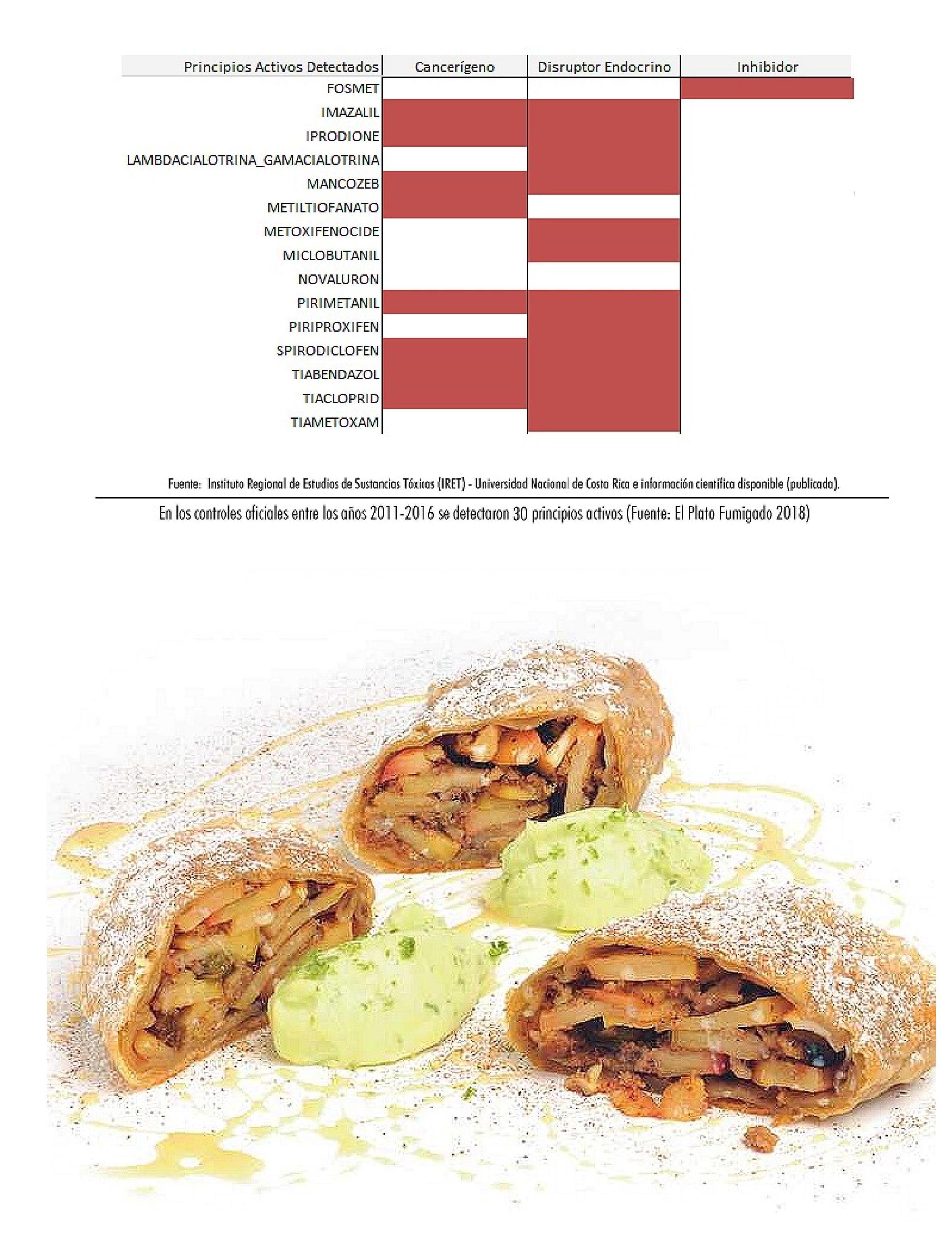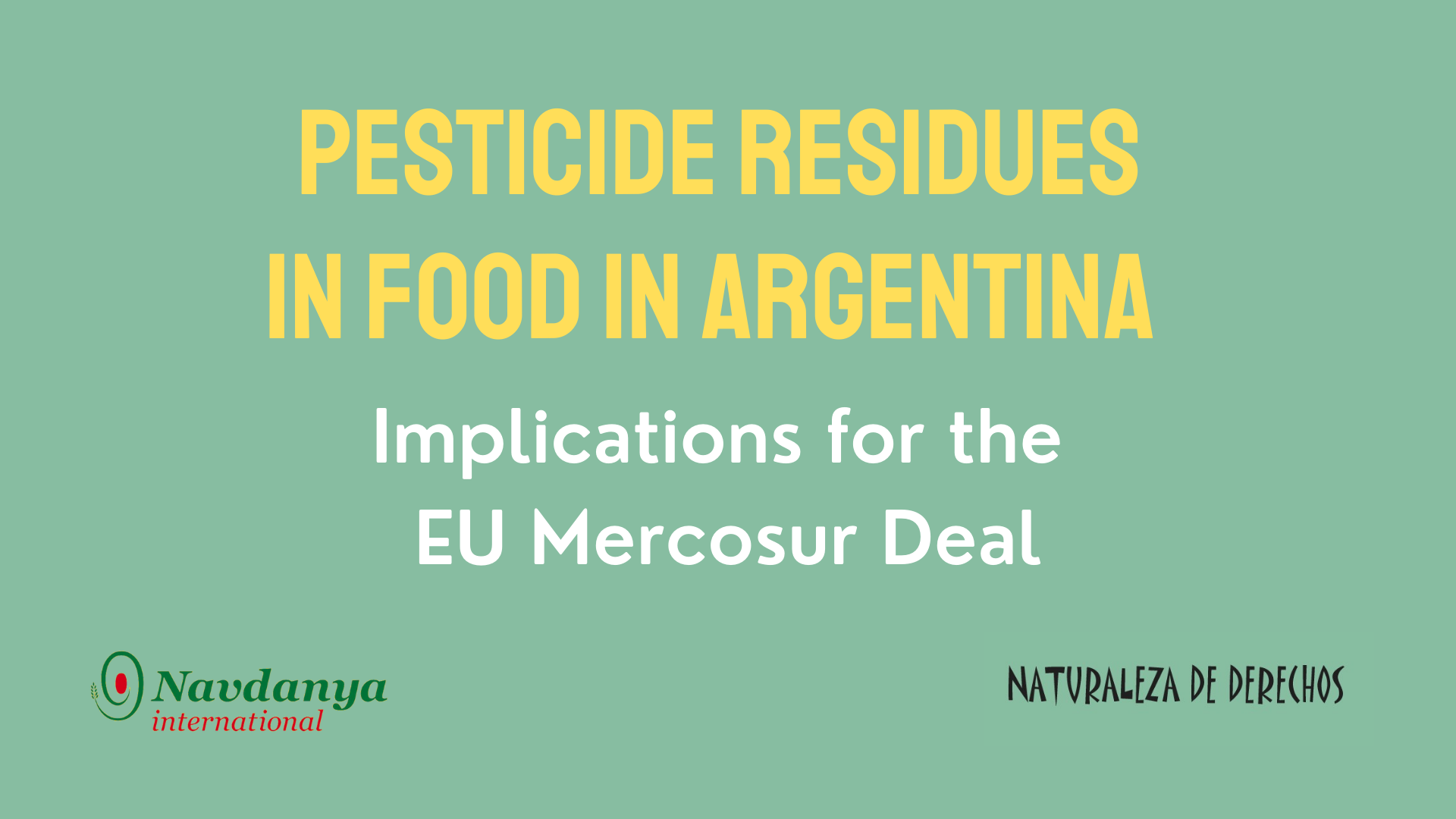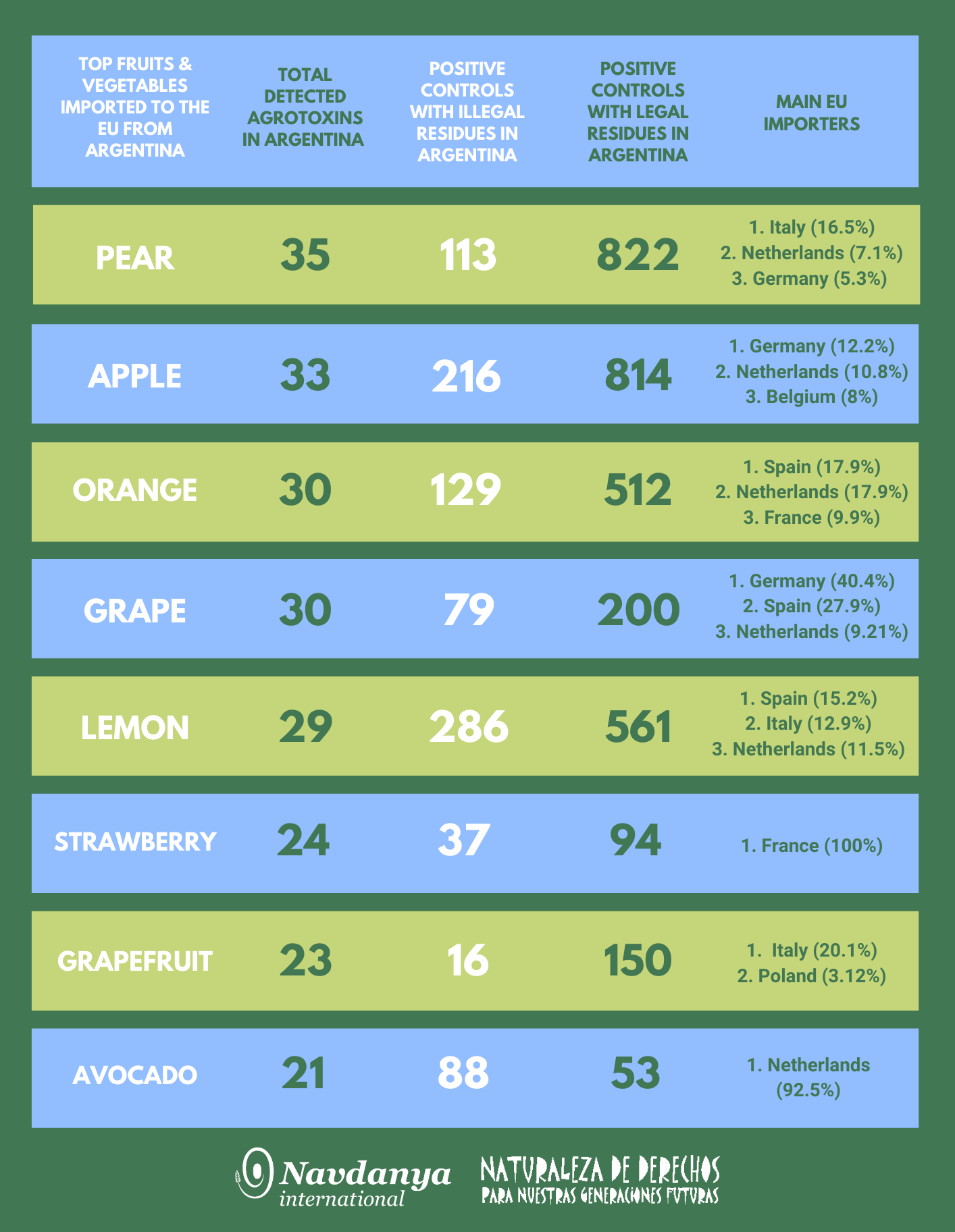For the last few months civil society has been calling for a reform of the EU-Mercosur trade agreement which produces a double standard when it comes to pesticide importation and exportation, especially in food and agriculture trade. Roughly 45.5% of EU imports from Mercosur countries are agricultural products, making the issue of pesticides central to the unbalanced trade relationship epitomized by this trade deal.[1]
The study below titled “Poisons continue to reach the plate: Food and agrochemical residues in Argentina” published by Naturaleza de Derechos, details the amount of positive test cases which detected the presence of pesticide residues in a variety of fruits and vegetables in Argentina.
Argentina is the second biggest exporter to the EU out of the Mercosur countries, meaning that several of the foods found to have very high pesticide residue rates, with some exceeding 100 times higher than the minimum residue level (MLR) allowed in Argentina, are being imported directly to EU tables. The top imported fruits and vegetables, including pears, apples, citrus, and grapes (including wine), were also some of the fruits and vegetables found to have the highest pesticide residue rates. For example, lemons mainly imported to Spain, Italy, and the Netherlands, tested positive for 29 different agrochemical residues. As detailed further below, apples and pears, mainly imported to Germany, Italy and the Netherlands, contained some of the highest rate of positive detection with 33 and 35 residues found respectively. Chart 1 details the fruits and vegetables found to have the highest pesticide residues that are imported into the EU from Argentina and the top EU consuming countries of each.
The study shows how residue levels far exceed the MLR set in Argentina for specific agrochemicals. Chart 2 shows the specific agrochemical residues found in pears and apples and the discrepancy between the allowed MRL in Argentina and the EU. The EU allows for higher MLR rates for pesticides than Argentina, but regardless several residues found far exceeded either MLRs.
Of the specific agrochemical residues detected, 50% are banned from use within the EU territory. This is where the double standard arises, as also through the Mercosur trade deal, agrochemical companies based in Europe go on to export the very pesticides banned within the EU territory to Mercosur countries. Europe controls 30% of the world’s pesticide market after the US and China, and in 2018-2019 it exported 7 million kilos of pesticides prohibited in the EU through Mercosur. In 2018, the EU exported 78 million euros worth of pesticides to Argentina alone.[2] It is no wonder then that illegal pesticide residues are amply found in fruits and vegetables destined for EU markets. Not to mention, as well as for internal South American consumption.
This is especially problematic, as the rhetoric of the European Green New Deal and the Farm to Fork strategy specifically toutes the EU’s commitment to lower pesticide usage in the territory. A rhetoric which does not align with the lack of ethics behind its trade policies with Mercosur countries. As stated in a report made by the Left coalition of the EU parliament, ”This double standard amounts to a tacit agreement that the citizens of Mercosur are “second-class citizens”, given that it is deemed permissible for them to be exposed to substances that are not tolerated in the EU.”[3]

Originally in: Mies Bombardi, Larissa. 2021. “Geography of Asymmetry: The Vicious Cycle of Pesticides and Colonialism in the Commercial Relationship between Mercosur and the European Union.” São Paulo; Brussels, Belgium: University of São Paulo/ Commissioned by the EU Parliament. https://documentcloud.adobe.com/link/review?uri=urn%3Aaaid%3Ascds%3AUS%3A5587d57e-d34a-4618-95a2-c291d30d47ab#pageNum=2.
Extract from:
El veneno continúa llegando al plato: Alimentos y residuos de agrotóxicos en Argentina (Poisons continue to reach the plate: Food and agrochemical residues in Argentina)[4]
Analysis and classification of the results of SENASA’s official controls on the presence of pesticides in fruits, vegetables, cereals and oilseeds, between 2017 and 2019, throughout Argentina.
–
Introduction / general considerations
In September 2020, the National Service for Agrifood Health and Quality of Argentina (SENASA) was asked to report on the results of the last three years (2017, 2018, 2019) of controls regularly carried out on samples taken from all over Argentina, on the presence of pesticides in fruits, vegetables, cereals and oilseeds. This data is public information that according to current legislation, the State is obliged to provide. However, when the extension period ended in November 2020, the SENASA still did not provide the requested data. After a new request with no response, and an intimation notifying the SENASA that the wait was concluded and the resortion to Federal Justice, the SENASA finally delivered the information on December 17, 2020, but with rhetorical justifications and inaccurate information.
The total number of controls (356,940) which the SENASA claims to have carried out between the period 2017 and 2019 makes it appear as much higher than in reality. The organisation fails to clarify that this number also includes the assessments on heavy metals, mycotoxins and microbiological substances carried out by the agency, instead of sticking to the data on pesticides residues in food which it was asked to provide. This is clearly an attempt to minimize the level of detections, and thereby reducing the incidence of positive cases (7,869) out of the total analyzed.
There is no official data on the amount of pesticides used per year in Argentina. According to the last precise data available dating from 2015 from the Chamber of Agricultural Health and Fertilizers (Casafe), and according to the increase in the sale of agrochemicals reported by specialized media and the figures of informal trade, projections conclude that the total annual amount of pesticides in 2021 is already over 600 million liters/ kilos. Not even the pandemic could stop the agribusiness model. During the quarantine, pesticide spraying was declared an essential activity and imports of supplies for the manufacture of commercial formulations continued.
Results
The SENASA detected 7,869 positive cases with pesticides present in a sample group of 48 fruits, vegetables, cereals and oilseeds. 80 active principles were found in total out of the controls on the 48 foods. Regarding the biocidal action of the 80 pesticides detected, 48% are insecticides, 41% fungicides, 10% herbicides and 1% antioxidants. As to the toxicological profile, of the 80 active principles found, 49% are carcinogens, 75% act as hormone disruptors, and 20% are cholinesterase inhibitors. Pepper, apple and pear were the three foods with the highest pesticide residues: respectively 37, 35 and 33 active principles were found among the positive cases, out of a total of 80 agrochemicals found by the SENASA. Grape (30), orange (30), tomato (30), lemon (29), peach (28), lettuce (26) and banana (24) were the foods that ranked among the ten most contaminated.
Carcinogenic agrotoxins in food
Out of the 80 pesticides detected in fruits, vegetables, greens, cereals and oilseeds, 49% (39) are considered probable or possible carcinogens according to the inventory of available scientific information and classifications from regulatory bodies and the International Agency for Research on Cancer (IARC).
A pesticide operates as a carcinogenic agent when there is a probability or possibility of generating carcinogenesis in the human body, due to its chronic indirect exposure, through the consumption of foods that contain it as a residue in very small amounts. Carcinogenesis is the process by which the cells of a human or animal organism transform into neoplastic cells, which lead to the formation of abnormal tissue masses in the body.
Small, repeated doses of carcinogen have cumulative effects, and the final result is determined by the total dose. Consequently, carcinogens require long periods of time before they develop a tumor. The time between exposure to chemical agents and the appearance of a tumor in humans ranges from five to 30 years. Most carcinogens can also act synergistically, mutually facilitating their action and increasing susceptibility. This means that the interaction of multiple carcinogenic agents, as found in pesticides residues in food, more than exposure to a single carcinogen, often increases the incidence of some human cancers.
Hormone-altering agrotoxins in food
Out of the 80 pesticides detected in foods, 75% (60) are considered endocrine disruptors according to the inventory of available scientific information and classification in the European Union.
Endocrine disruptors are chemical substances capable of altering the hormonal system, responsible for multiple vital functions such as growth or sexual development. By mimicking or altering the effect of hormones, endocrine agents can send confusing messages to the body, causing various dysfunctions. Scientific research has linked endocrine disruptors to a wide number of diseases, affecting female and male reproductive health, causing metabolism disorders (obesity, diabetes), cardiovascular problems and neurological diseases. The risk is particularly high for pregnant women and children: exposure to endocrine disruptors during the first stages of life can cause irreversible lesions, leading to pathologies or diseases.
Like carcinogens, endocrine disruptors act at very low doses. Not to mention the bioaccumulation threshold of harm to human health being hard to ascertain as an endocrine disruptor can remain in the body indefinitely, taking a long time before operating. Likewise, its effects can be enhanced through synergy with other endocrine disruptors.
Cholinesterase inhibitors in food
Of the 80 pesticides detected in foods, 20% (16) are considered cholinesterase inhibitors according to the inventory of available scientific information.
Many pesticides (insecticides) work through the insects’ transmissions of nervous stimuli, exerting a lethal effect to eliminate them from crops. Scientific research has shown that this effect of pesticides on insects can also extend to human beings who are exposed to these types of chemicals, either directly (aerial or ground fumigations) or indirectly (residues in food). The mode of action of these pesticides is the inhibition of the acetylcholinesterase enzyme. When acetylcholinesterase is not available in the synaptic cleft, excessive accumulation of the neurotransmitter occurs, causing constant stimulation of the receptors, which can result in a cholinergic crisis, characterized by overstimulation of muscles, glands and nerves.
The SENASA legislation does not guarantee food safety
A positive case with pesticide residues does not mean that it is outside the SENASA’s legal regulations: 69% of the positive cases conform to the current resolutions 934/2010 and 608/2012 which indicate the “maximum residue limits (MRL)” allowed. However, the fact that residues are within the legal margin does not imply food safety at all. In fact, 47% of the active ingredients of pesticides detected were prohibited (certain uses or total ban) in the European Union.
The European Food Safety Authority (EFSA) ruled the prohibition or partial cancellation of 38 active principles that are part of the 80 detected in the 48 foods analyzed in Argentina. However, the SENASA did not do the same at the local level, even though it should have been obliged to act since the decisions adopted in the European Union were based on relevant and available scientific information.
Besides, the volume of positive cases of pesticide residues in food should require a comprehensive evaluation of the daily chemical load and the real level of risk to which the population is exposed when consuming these 48 essential foods. For this reason, the SENASA’s segmented analysis of each of the values of the substances detected separately, ignoring the potential effects of mixing these substances together, is a denialist perspective. Given the information published by the European Commission on the inventory of endocrine disruptors, the continuity of the MLR allowed by the SENASA’s resolutions, which do not take into account the synergistic and epigenetic effects and do not have an empirical verification on chronic and carcinogens effects, are unconstitutional because they represent a violation of the right to health.
These omissions, both with respect to the requirement to evaluate the synergistic and epigenetic effects of pesticide residues in food, and to proceed with the restriction of the active principles that were prohibited or restricted in the European Union, are breaches of the duties of SENASA public officials.
Food for Health Manifesto
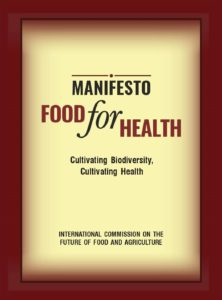 In 2019, Navdanya International produced with a group of experts a document on the importance of the right to food as a fundamental requirement for good health, of both humans and the Earth.[5] The Manifesto offers scientific evidence, sustained by more than 200 bibliographical references to scientific studies and papers to show how the right to health can only be fulfilled if the right to good nutrition is recognized, respected and fulfilled through an ecologically-centered food systems change. It aims at raising the alarm about how pesticides, fertilizers and agrochemicals are producing damages to human health– from the farmers who use these chemical pesticides and herbicides, to the final consumers of pesticide residues in food. Additionally, agrochemicals pollute air, water and soils, damaging ecosystems and threatening biodiversity.
In 2019, Navdanya International produced with a group of experts a document on the importance of the right to food as a fundamental requirement for good health, of both humans and the Earth.[5] The Manifesto offers scientific evidence, sustained by more than 200 bibliographical references to scientific studies and papers to show how the right to health can only be fulfilled if the right to good nutrition is recognized, respected and fulfilled through an ecologically-centered food systems change. It aims at raising the alarm about how pesticides, fertilizers and agrochemicals are producing damages to human health– from the farmers who use these chemical pesticides and herbicides, to the final consumers of pesticide residues in food. Additionally, agrochemicals pollute air, water and soils, damaging ecosystems and threatening biodiversity.
The analysis of the results produced by the official controls of SENASA in Argentina on the presence of pesticides residues in foods confirms the seriousness of the situation described by the Food for Health Manifesto, consolidating the arguments on the imperative need to start the process of structural change in the food production system.
#StopEuMercosur International Campaign

In June 2020, 265 European and international organisations launched the #StopEuMercosur campaign to stop the approval of a trade liberalisation treaty between the European Union and the South American Common Market (Mercosur), comprising Argentina, Brazil, Paraguay and Uruguay.
In light of the campaign, in March 2021 a coalition of +450 civil society organisations was launched. The coalition statement is a call on political leaders to recognize that:
- The EU-Mercosur serves corporate interests at the expense of planetary boundaries and animal welfare, and drives untenable social inequalities, by perpetuating an extractive model of agriculture exemplified by overgrazing, expansion of feedlots and chemically intensive monocultures.
- The goals and core elements of this agreement are in direct opposition to climate action, food sovereignty and upholding human rights and animal well-being.
- The trade deal will destroy livelihoods in both Europe and in South America, hurting family farms and workers, by perpetuating the path dependency of South American economies as cheap exporters of raw materials obtained through destruction of vital natural resources rather than fostering the development of sound, diversified and resilient economies.
- A 21st century trade model must support rather than undermine efforts to create socially just and ecologically resilient societies based on the principles of solidarity, protection of human rights and our planetary boundaries.
The EU-Mercosur treaty aims to create the world’s largest free trade area, covering 800 million people. Deregulation of trade between the two blocs will promote an increase in European imports of beef, soya and biofuels, in exchange for greater car exports to South American countries. An exchange with heavy externalities whose weight will fall on areas, such as the Amazon forest, already severely affected by fires and deforestation caused by large livestock breeders and farmers.
At a time when the climate and social crisis is more serious than ever, it is totally unacceptable to propose economic and commercial prescriptions based on the elimination of controls on production methods and subsequent products that are devastating ecosystems and communities.
References
[1] https://ec.europa.eu/trade/policy/countries-and-regions/regions/mercosur/
[2] Mies Bombardi, Larissa. 2021. “Geography of Asymmetry: The Vicious Cycle of Pesticides and Colonialism in the Commercial Relationship between Mercosur and the European Union.” São Paulo; Brussels, Belgium: University of São Paulo/ Commissioned by the EU Parliament. https://documentcloud.adobe.com/link/review?uri=urn%3Aaaid%3Ascds%3AUS%3A5587d57e-d34a-4618-95a2-c291d30d47ab#pageNum=2.
[3] Mies Bombardi, Larissa. 2021. “Geography of Asymmetry: The Vicious Cycle of Pesticides and Colonialism in the Commercial Relationship between Mercosur and the European Union.” São Paulo; Brussels, Belgium: University of São Paulo/ Commissioned by theEU Parliament. Pg. 30. https://documentcloud.adobe.com/link/review?uri=urn%3Aaaid%3Ascds%3AUS%3A5587d57e-d34a-4618-95a2-c291d30d47ab#pageNum=2.
[4] https://navdanyainternational.org/es/publications/alimentos-residuos-de-agrotoxicos-en-la-argentina/
[5] Food for Health Manifesto. Navdanya International, 2019, https://navdanyainternational.org/publications/manifesto-food-for-health/
Infographics
